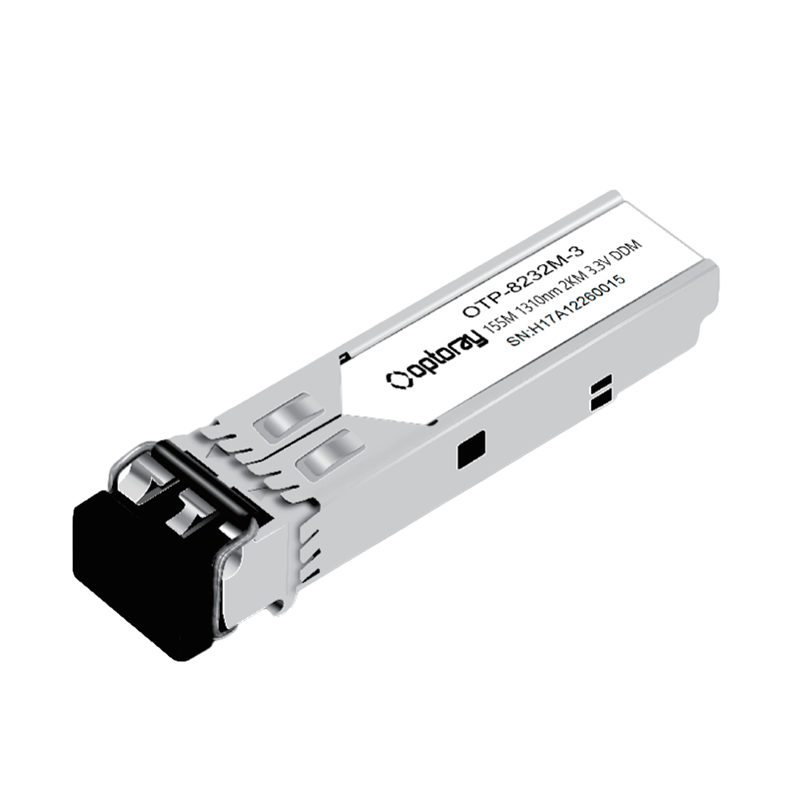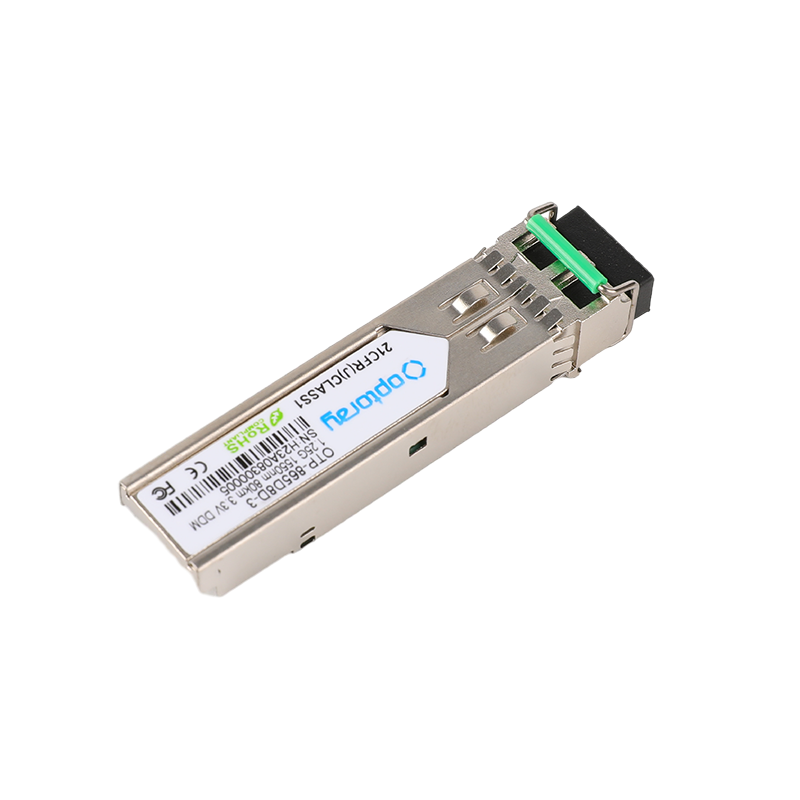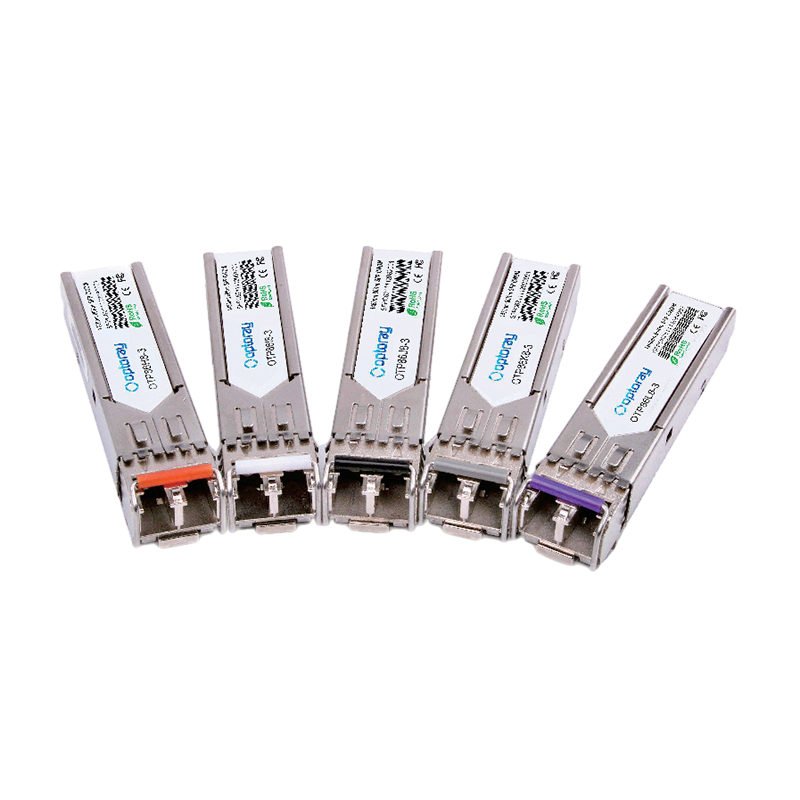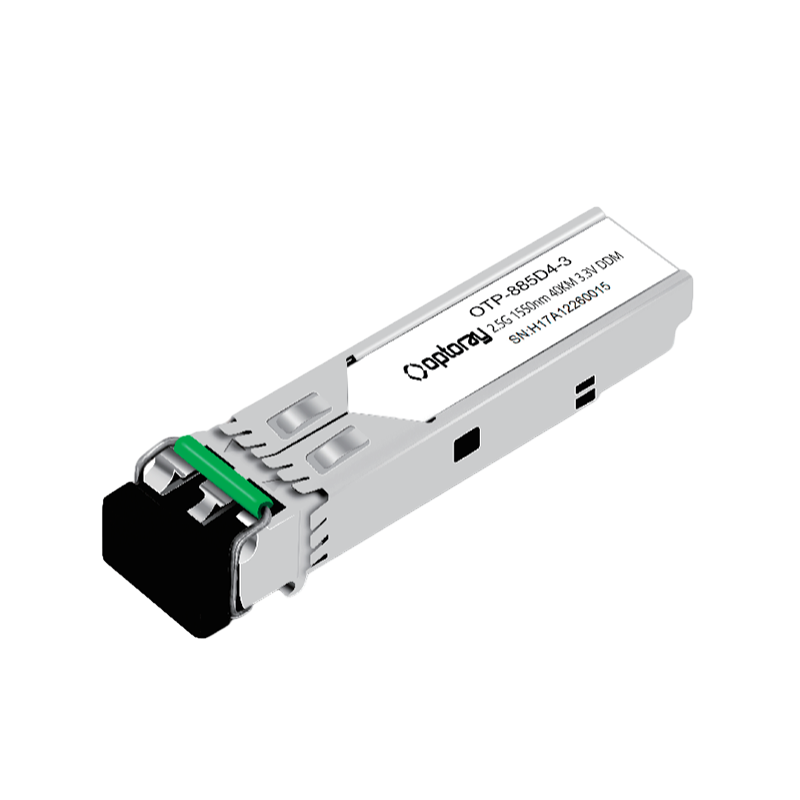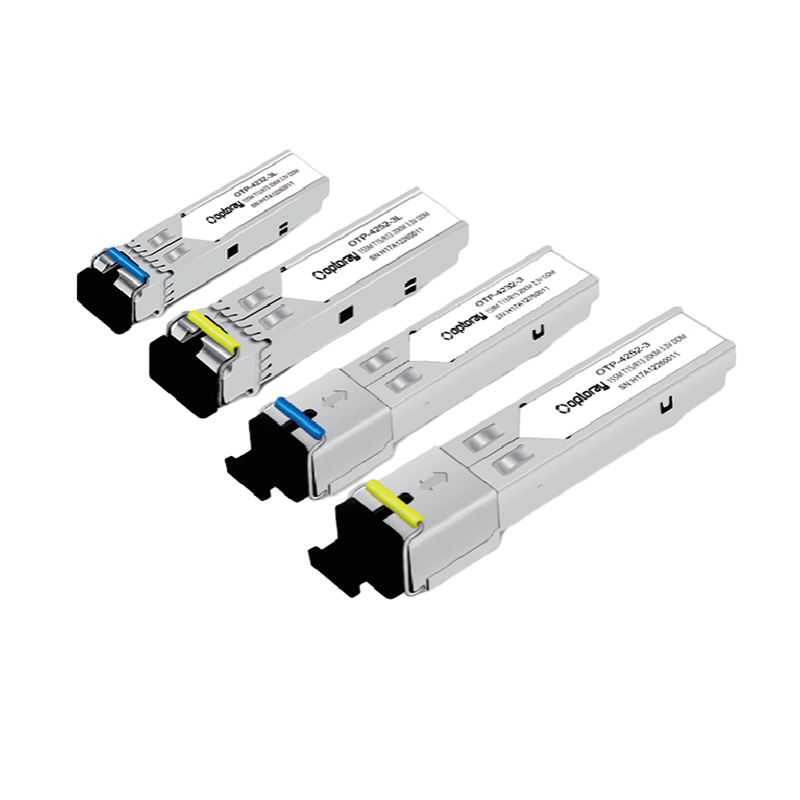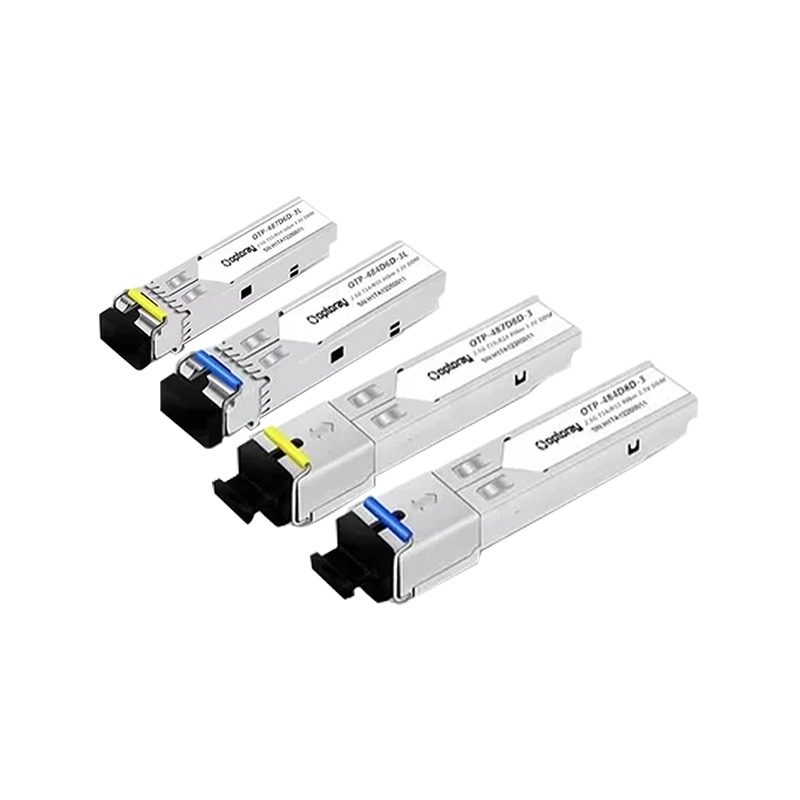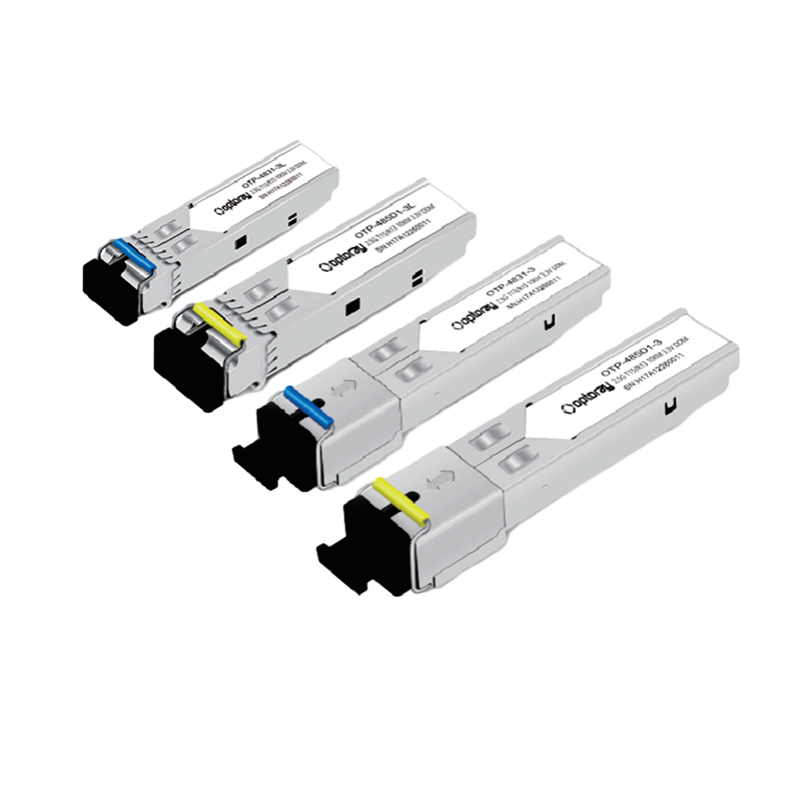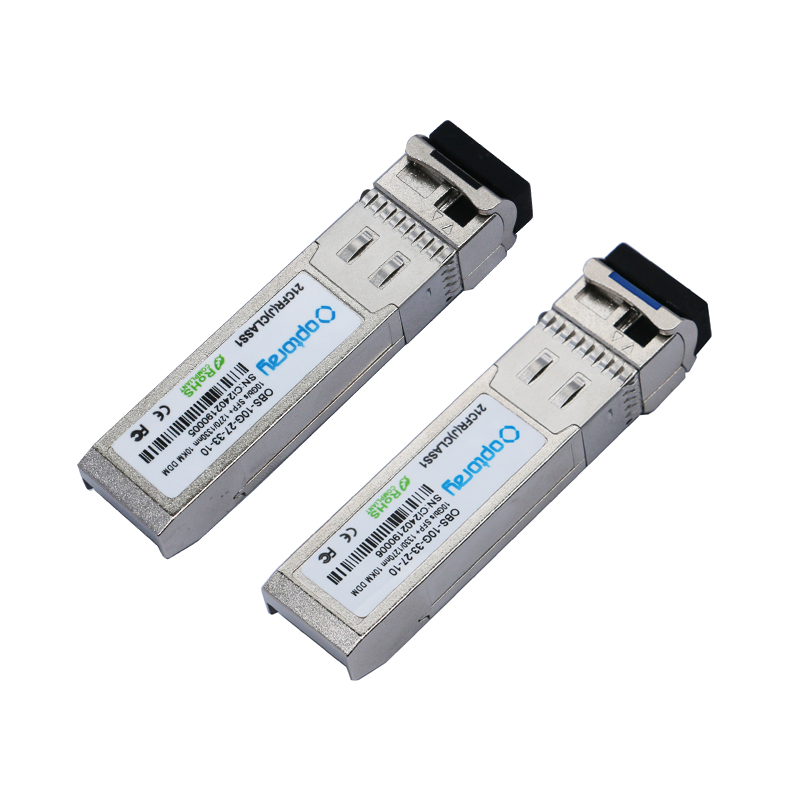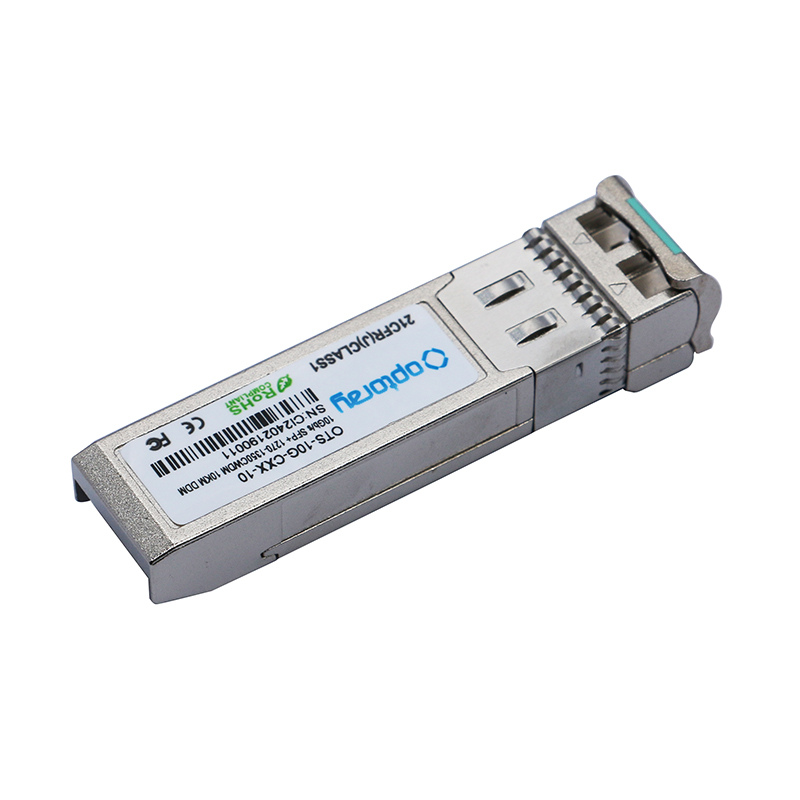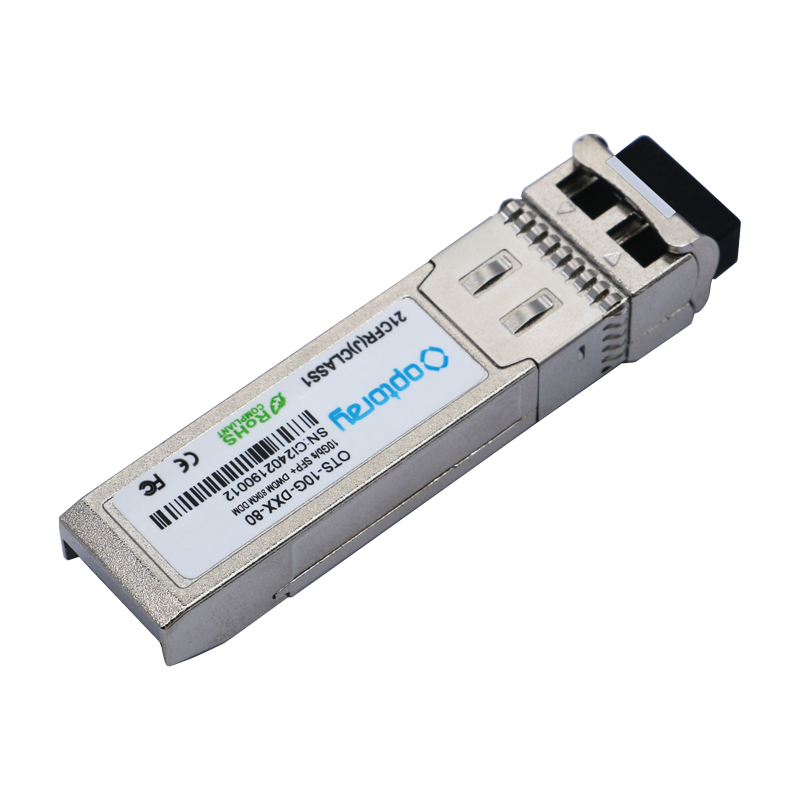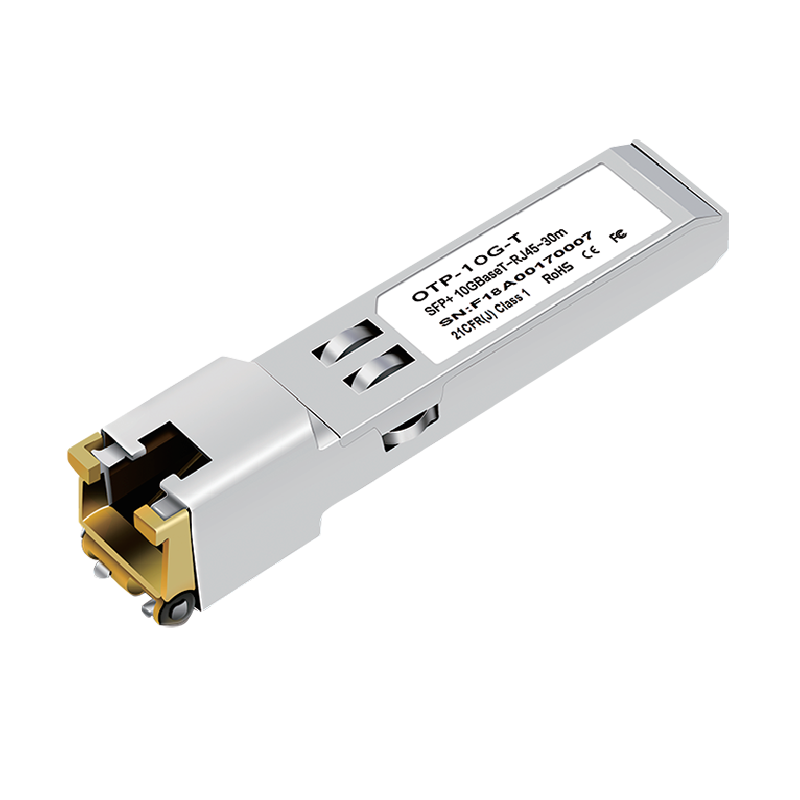+86-0559-5290604
Comprehensive analysis of SFP MODULE: from basics to applications
I. Introduction
(I) The important position of SFP MODULE in the field of communication
In the modern and rapidly developing communication network architecture, SFP (Small Form-Factor Pluggable) MODULE, that is, small pluggable module, has become a key basic component. With the exponential growth of data traffic, whether it is the high-speed exchange and transmission of massive data within the data center, or the long-distance and large-capacity information interaction in the wide area network, or the enterprise campus network to meet the needs of high bandwidth and low latency for daily office and business expansion, SFP MODULE plays an irreplaceable role. It is one of the core elements to ensure efficient and stable operation of the network.
(II) Industry development trend and its impact on SFP MODULE

At present, the communication industry is striding towards cutting-edge fields such as 5G, Internet of Things, and cloud computing. The large-scale deployment of 5G networks has put forward extremely high requirements on the transmission rate and capacity between base stations and between base stations and core networks. SFP MODULE needs to have a higher rate, such as evolving from traditional 1G and 10G to 25G, 100G or even higher rates to adapt to the fronthaul, midhaul and backhaul links of 5G networks. The rise of the Internet of Things has enabled tens of billions of devices to access the network, which has prompted SFP MODULE to continuously optimize costs and power consumption while supporting more connections to meet the characteristics of low power consumption and large-scale deployment of IoT devices. The vigorous development of cloud computing has promoted the continuous expansion and upgrading of data centers. The interconnection of servers within data centers, the high-speed communication of storage devices and computing nodes all rely on SFP MODULE to achieve high-density and high-speed data transmission, which has led to innovative demands for SFP MODULE in terms of performance, density and compatibility. 2. Basic Overview of SFP MODULE
(I) Definition and Basic Concepts
Definition of SFP MODULE: SFP MODULE is a hot-swappable small package module designed to provide flexible optoelectronic interface solutions for network devices (such as switches, routers, server network cards, etc.). It can convert electrical signals into optical signals for optical fiber transmission, or vice versa, convert received optical signals into electrical signals to achieve efficient connection between network devices and optical fiber links. This plug-and-play feature improves network operation and maintenance efficiency by more than 30%, greatly reducing manual maintenance costs.
Differences from other modules (such as GBIC, etc.): Compared with the early Gigabit Interface Converter (GBIC), SFP MODULE has achieved a significant reduction in size, with a volume of only about half that of GBIC, which enables network devices to configure more ports in a limited panel space, significantly improving port density. In terms of function, although both have optoelectronic conversion capabilities, SFP MODULE is more advanced in technology, supports higher data transmission rates, and has better performance in power consumption, heat dissipation, and compatibility. For example, GBIC usually supports a maximum rate of 1Gbps, while SFP MODULE can not only easily handle 1Gbps, but also expand to 10Gbps and higher rates. After a certain model of switch adopts SFP ports, the port density per unit area is increased from 8 ports in the GBIC era to 32 ports, and the space utilization rate is increased by 4 times.
(II) Structural analysis

Internal components (lasers, detectors, etc.): The SFP MODULE is mainly composed of core components such as lasers (used to convert electrical signals into optical signals for emission, including vertical cavity surface emitting lasers VCSEL and edge emitting lasers EEL, and different types are suitable for different transmission distances and rate requirements), detectors (responsible for converting received optical signals back to electrical signals, common ones are PIN photodiodes and avalanche photodiodes APD), signal processing circuits (modulation, demodulation, amplification, shaping, etc. of electrical signals to ensure accurate transmission and reception of signals) and control circuits (used to monitor and control the working status of the module, such as temperature, bias current, etc.). Taking the 10G SFP+ module as an example, its VCSEL laser operates at a wavelength of 850nm. With the APD detector, it can achieve 300 meters of stable transmission on multimode optical fiber.
External interface design (LC interface, etc.): The external interface of SFP MODULE usually adopts LC (Lucent Connector) interface, which has the advantages of small size, convenient connection, and high-density wiring. The LC interface is a duplex design, which realizes the sending and receiving of optical signals through two optical fiber interfaces respectively, ensuring two-way transmission of data. Its plug-in design makes the module extremely convenient to install and replace, without the need for complex tools and professional skills, greatly improving the efficiency of network deployment and maintenance. After a data center adopted the LC interface SFP module, the wiring time was shortened from 4 hours/cabinet of the traditional interface to 1.5 hours.
III. Working principle of SFP MODULE
(I) Photoelectric conversion mechanism
The process of converting electrical signals to optical signals: When the electrical signal of the network device is transmitted to the SFP MODULE, it first enters the laser drive circuit. The circuit accurately adjusts the bias current provided to the laser according to the amplitude and frequency changes of the input electrical signal. Driven by the bias current, the laser generates an optical signal corresponding to the input electrical signal. For example, for the digital signal "1", the laser outputs a strong optical power; for the digital signal "0", the laser outputs a weak or no output optical power. In this way, the conversion of electrical signals to optical signals is realized, and the converted optical signals are coupled into the optical fiber through the optical fiber interface for transmission. The SFP module using direct modulation technology has a modulation rate of up to 28Gbps, which meets the fronthaul requirements of the 5G network.
The process of converting optical signals to electrical signals: At the receiving end, the optical signal transmitted by the optical fiber enters the detector of the SFP MODULE. The detector converts the received optical power into a corresponding electrical signal. The generated electrical signal is usually very weak and needs to be amplified by a preamplifier. The amplified electrical signal is then shaped and restored to the original digital signal through subsequent signal processing circuits, such as limiting amplifiers and decision circuits. Finally, the processed electrical signal is transmitted to the network equipment to complete the conversion process from optical signals to electrical signals. Advanced equalization technology can increase the receiving sensitivity to -28dBm and extend the transmission distance.
(II) Data transmission process
Data processing and transmission at the transmitting end: At the transmitting end, the network equipment sends the data to be transmitted to the SFP MODULE in the form of electrical signals. After entering the SFP MODULE, the data is first encoded by the encoding circuit, such as 8B/10B encoding, to improve the reliability and anti-interference ability of data transmission. The encoded data is modulated to the laser by the laser driving circuit, converted into an optical signal and sent out through the optical fiber. During this process, the SFP MODULE also monitors and adjusts the power of the transmitted optical signal to ensure that the optical signal strength is within the appropriate range of optical fiber transmission to ensure the effective transmission distance and quality of the signal. The 25G SFP28 module deployed by an operator controls the optical power fluctuation range within ±0.5dB through the automatic power control function.
Data reception and recovery at the receiving end: At the receiving end, the SFP MODULE receives the optical signal from the optical fiber through the detector and converts it into an electrical signal. After pre-amplification and filtering, the electrical signal enters the decoding circuit for decoding to restore the original data signal. At the same time, the SFP MODULE at the receiving end will monitor the quality of the received signal, such as indicators such as bit error rate. If the signal quality is found to be poor, the sending end will be notified through the feedback mechanism to adjust the sending parameters, or the received signal will be corrected to ensure that the data finally transmitted to the network device is accurate. The 100G QSFP28 module deployed in a data center uses FEC forward error correction technology to reduce the bit error rate from 10^-4 to 10^-15.
IV. Classification of SFP MODULE types
(I) Classification by transmission rate
1Gbps SFP MODULE: 1Gbps SFP MODULE is a relatively basic and common type, widely used in early Gigabit Ethernet networks. In enterprise campus networks, it is often used to connect office equipment such as desktop computers and printers to network switches to provide stable Gigabit network access. The transmission distance varies according to the type of optical fiber and wavelength used. When multimode optical fiber is matched with 850nm wavelength, the transmission distance can generally reach about 550m; when single-mode optical fiber is matched with 1310nm wavelength, the transmission distance can be extended to 10km or even further. Common models include SFP-1G-SX (multimode short distance), SFP-1G-LX (single-mode long distance), etc.
10Gbps SFP+ MODULE: With the growth of bandwidth demand for network applications, 10Gbps SFP+ MODULE came into being. It has been widely used in the internal network of data centers for high-speed interconnection between servers, connection between storage devices and servers in storage area networks (SANs), and other scenarios. SFP+ MODULE achieves 10Gbps high-speed data transmission by optimizing internal circuit design and using higher-speed lasers, detectors and other components. In terms of transmission distance, when multimode optical fiber is used with new optical fibers such as OM3 and OM4, it can support a transmission distance of 300m-500m; when single-mode optical fiber is used with 1310nm and 1550nm wavelengths, the transmission distance can reach 10km-40km, such as SFP+-10G-SR (multimode short-distance), SFP+-10G-LR (single-mode long-distance) and other models. Google data centers use SFP+-10G-SR modules to achieve high-speed interconnection between racks. 25Gbps SFP28 MODULE: 25Gbps SFP28 MODULE is a product that adapts to the higher bandwidth requirements of 5G network construction and data center upgrades. In the fronthaul and midhaul links of 5G base stations, SFP28 MODULE is used to achieve high-speed connection between base station equipment and optical fiber networks, ensuring fast transmission of base station data. In the data center, it can be used to upgrade the existing network architecture, increase the transmission rate of the network switch port, and achieve more efficient data exchange. SFP28 MODULE adopts advanced 28nm process technology, which reduces power consumption and improves integration. In terms of transmission distance, multimode fiber can support about 100m-200m, and single-mode fiber can achieve 10km-40km transmission at different wavelengths, such as SFP28-25G-SR (multimode short distance), SFP28-25G-LR (single-mode long distance), etc.
Higher rate (such as 100Gbps QSFP28 and other derivative types): In order to meet the extreme demand for high-speed transmission of massive data in ultra-large-scale data centers, high-performance computing and other fields, higher-rate modules such as 100Gbps QSFP28 have appeared one after another. The QSFP28 module adopts a four-channel design, and the data transmission rate of each channel can reach 25Gbps. The four channels work in parallel to achieve a total transmission rate of 100Gbps. In the core network layer of the data center, QSFP28 modules are used for high-speed interconnection between switches to build a low-latency, high-bandwidth data transmission backbone network. Its transmission distance can reach about 100m under multi-mode optical fiber, and single-mode optical fiber with different wavelengths can achieve long-distance transmission of 40km-80km, such as QSFP28-100G-SR4 (multi-mode short distance), QSFP28-100G-LR4 (single-mode long distance) and other models. With the development of technology, the transmission performance is constantly optimized and the application scenarios are expanded. AWS data centers use QSFP28-100G-LR4 modules to build a global backbone network.
(II) Classification by transmission medium
Multi-mode SFP MODULE: Multi-mode SFP MODULE is suitable for short-distance, high-bandwidth communication scenarios, such as connections between buildings within enterprise campus networks and between racks within data centers. It uses multimode optical fiber as the transmission medium. The core diameter of multimode optical fiber is relatively thick (commonly 50μm or 62.5μm), allowing multiple light modes to be transmitted in it. Multimode SFP MODULE usually uses 850nm wavelength VCSEL laser as the light source. Due to the mode dispersion when light is transmitted in multimode optical fiber, the signal will be distorted as the transmission distance increases. Therefore, its transmission distance is generally short. At a rate of 1Gbps, the transmission distance can reach 550m using ordinary multimode optical fiber; at 10Gbps and higher rates, it needs to be matched with new multimode optical fibers such as OM3 and OM4, and the transmission distance can be increased to about 300m-500m. Multimode SFP MODULE has the advantages of relatively low cost and simple installation and maintenance. It is suitable for network deployment scenarios that do not require high transmission distance but are sensitive to cost.
Single-mode SFP MODULE: Single-mode SFP MODULE is mainly used for long-distance, large-capacity data transmission, such as metropolitan area network connection in wide area network, long-distance backbone network transmission, and cross-regional interconnection between data centers. It uses single-mode optical fiber as the transmission medium. The core diameter of single-mode optical fiber is relatively thin (usually 9μm), which only allows one optical mode to be transmitted in it, greatly reducing mode dispersion, so as to achieve longer distance transmission. Single-mode SFP MODULE
E generally uses EEL lasers with a wavelength of 1310nm or 1550nm as the light source. At a wavelength of 1310nm, the transmission distance can reach 10km-20km; at a wavelength of 1550nm, with the appropriate optical amplifier, the transmission distance can be extended to 40km-160km or even further. Although the cost of single-mode SFP MODULE is relatively high, it has incomparable advantages in long-distance transmission and can ensure the stability and reliability of the signal during long-distance transmission.
(III) Special function type
BIDI SFP MODULE (bidirectional transmission module): BIDI (Bidirectional) SFP MODULE is a bidirectional transmission module, which realizes bidirectional transmission of data on one optical fiber, effectively saving optical fiber resources. Its working principle is to use wavelength division multiplexing technology to modulate the transmitted and received optical signals to different wavelengths respectively and transmit them in the same optical fiber. For example, the common BIDI SFP MODULE modulates the transmit signal to 1310nm wavelength and the receive signal to 1550nm wavelength, and realizes the separation and transmission of bidirectional signals through special filtering and coupling devices. In some old network upgrade scenarios with tight fiber resources, or places that are extremely cost-sensitive and difficult to wire, such as small enterprise office networks and communication networks in remote areas, BIDI SFP MODULE has significant advantages. It can not only meet network communication needs, but also reduce the cost and construction difficulty of fiber laying. The renovation of an old community uses BIDI SFP modules, saving 50% of fiber resources.
CWDM SFP MODULE (Coarse Wavelength Division Multiplexing Module): CWDM (Coarse Wavelength Division Multiplexing) SFP MODULE is a coarse wavelength division multiplexing module, which greatly improves the transmission capacity of optical fiber by multiplexing multiple optical signals of different wavelengths on the same optical fiber. CWDM SFP MODULE usually uses 8 or 16 wavelengths in the wavelength range of 1270nm - 1610nm, with each wavelength interval of about 20nm. In the metropolitan area network, the data of multiple users can be multiplexed on one optical fiber to the core node through CWDM SFP MODULE of different wavelengths, realizing the efficient use of optical fiber resources. Compared with traditional single-wavelength transmission, CWDM SFP MODULE does not need to lay a large amount of optical fiber, which reduces the construction cost and the complexity of optical fiber management.
DWDM SFP MODULE (Dense Wavelength Division Multiplexing Module): DWDM (Dense Wavelength Division Multiplexing) SFP MODULE is a dense wavelength division multiplexing module. Compared with CWDM, it can multiplex more optical signals in a narrower wavelength interval to achieve higher optical fiber transmission capacity. DWDM SFP MODULE generally uses a wavelength range of 1530nm - 1565nm, with a wavelength interval as small as 0.4nm or less, and can multiplex 80 or more wavelengths on a single optical fiber. DWDM SFP MODULE plays a key role in scenarios with extremely high transmission capacity requirements, such as long-distance backbone networks and high-speed interconnection between ultra-large data centers. Through DWDM technology, a single optical fiber can carry a data transmission rate of several terabits or even higher, meeting the needs of rapid transmission of massive data worldwide. Although the equipment cost and technical complexity of DWDM SFP MODULE are high, in the application scenario of long-distance and large-capacity transmission, the economic benefits and network performance improvement it brings far exceed the cost investment.
V. SFP MODULE application field
(I) Data center
Server interconnection: In the data center, SFP MODULE is widely used for interconnection between servers. With the popularization of applications such as cloud computing and big data analysis, servers in data centers need to exchange data at high speed and stably. Modules such as SFP+, SFP28, and QSFP28 with a rate of 10Gbps and above are widely used to connect server network cards and network switches, realizing high-speed data sharing and collaborative work within server clusters. For example, in large-scale cloud computing data centers, multiple servers are connected to core switches through 100Gbps QSFP28 modules to ensure that operations such as virtual machine migration, data backup and recovery can be completed in a short time, improving the operational efficiency and service quality of the data center.
Storage area network (SAN) connection: In a storage area network, SFP MODULE is used to connect storage devices (such as disk arrays, tape libraries, etc.) to servers or storage switches. With the explosive growth of enterprise data volume, SAN has higher requirements for the stability and speed of data transmission. Taking the financial industry as an example, bank transaction data, customer information, etc. need to be stored and backed up in real time. Fiber Channel SFP MODULE of 16Gbps or 32Gbps can ensure high-speed and stable transmission of data between storage devices and servers.
(II) Telecom Operator Network
5G base station transmission: In the 5G network architecture, SFP MODULE is the core component of the base station transmission link. In the fronthaul of the base station, the 25G SFP28 module achieves efficient connection between the distributed unit (DU) and the active antenna unit (AAU) with its high speed and miniaturization advantages; in the midhaul and backhaul links, 100G QSFP28 or even 400G QSFP-DD modules need to be selected according to the distance and capacity. At the same time, in order to cope with the further demand for transmission bandwidth of 5G-Advanced in the future, operators have begun testing 50G SFP56 modules to prepare for network upgrades.
Fiber broadband access (FTTH, etc.): In the fiber-to-the-home (FTTH) scenario, SFP MODULE builds a high-speed data channel between the optical line terminal (OLT) and the optical network unit (ONU). As home users' demand for 8K video, VR applications, etc. increases, 10G-EPON and XG-PON technologies are gradually becoming popular, and 10G SFP+ modules have become the standard configuration of OLT equipment.
(III) Enterprise network
Campus network backbone connection: In the enterprise campus network, the backbone links between different buildings require high-bandwidth, low-latency connections. 10G or 25G SFP modules are often used to connect the campus core switch and the building switch to ensure the stable transmission of voice, video conferencing, and business system data. For example, a large manufacturing enterprise park built a backbone network by deploying 25G SFP28 modules, realizing high-speed interconnection between various factory areas and office buildings, ensuring real-time data interaction between production management systems and ERP systems, and improving the overall operational efficiency of the enterprise. At the same time, some companies have begun to use CWDM SFP modules to carry multiple services on one optical fiber, simplifying the network architecture while reducing wiring costs.
Branch office interconnection: For widely distributed enterprise branch offices, SFP MODULE provides a flexible solution for their interconnection with the headquarters network. Single-mode SFP modules, combined with leased operator dedicated lines, can achieve long-distance, secure and reliable data transmission. Small branches can use BIDI SFP modules to achieve two-way communication using a single optical fiber, saving optical fiber resources.
VI. SFP MODULE Industry Challenges and Responses
(I) Technical Challenges
Signal integrity at high rates: As the transmission rate increases to 100G or even 400G, signal attenuation, crosstalk and jitter problems become more serious. Manufacturers need to ensure signal integrity by optimizing laser and detector performance and improving signal processing algorithms, such as using high-order modulation technology (PAM4) and more advanced equalization technology. For example, in the 400G QSFP-DD module, PAM4 modulation technology increases the number of bits transmitted per symbol to 4 bits, effectively improving the transmission rate, but also placing higher requirements on signal processing.
Power consumption and heat dissipation control: The power consumption of high-speed SFP modules has increased significantly. For example, the power consumption of 100G QSFP28 modules can reach 7-8W. The centralized deployment of a large number of modules will cause heat dissipation problems. To this end, manufacturers use new semiconductor materials and optimize circuit design to reduce power consumption, while improving the module packaging structure and enhancing heat dissipation performance, such as using metal heat sinks and optimizing air duct design.
(II) Market Challenges
Cost pressure: Driven by 5G construction and data center expansion, the demand for SFP modules has increased significantly, but the market competition is fierce and prices are constantly falling. Manufacturers need to reduce costs through large-scale production and technological innovation, and develop differentiated products, such as customized modules for specific industry needs, to increase product added value.
Compatibility and interoperability: There may be compatibility issues between SFP modules and network equipment from different manufacturers. Industry organizations such as MSA (Multi-Source Agreement) ensure the interoperability of products from different manufacturers by formulating unified standards. Users also need to strictly test the compatibility of modules and equipment when purchasing to avoid network failures.
VII. Future development trend of SFP MODULE
Higher transmission rate: With the development of technologies such as artificial intelligence and big data, the demand for transmission rate continues to grow. 400G, 800G and even 1.6T SFP modules have entered the research and development and testing stage and will be gradually commercialized in the future.
Integration and intelligence: SFP modules will integrate more functions, such as built-in intelligent monitoring chips to achieve real-time monitoring of module status and fault warning; at the same time, they will be deeply integrated with the management system of network equipment to improve the intelligent level of network operation and maintenance.
Green energy saving: low-power devices and energy-saving designs are used to reduce module power consumption, which meets the green development needs of data centers and communication networks. For example, some manufacturers have launched 100G SFP modules with power consumption below 5W to reduce energy consumption and heat dissipation costs.
Expansion of new application scenarios: With the development of cutting-edge technologies such as 6G and quantum communication, SFP modules will play a role in more fields, such as optical signal transmission in quantum key distribution systems, bringing new development opportunities to the industry.
VIII. Conclusion
SFP MODULE has become an indispensable key component of modern communication networks due to its flexibility, high performance and wide applicability. From data centers to telecommunications networks, from enterprise campuses to home users, SFP MODULE supports the efficient transmission of massive data. Despite the dual challenges of technology and market, driven by the continuous innovation of the industry, SFP MODULE will develop in the direction of higher speed, lower power consumption and more intelligence, providing solid guarantee for the upgrade and transformation of future communication networks.



 English
English русский
русский


